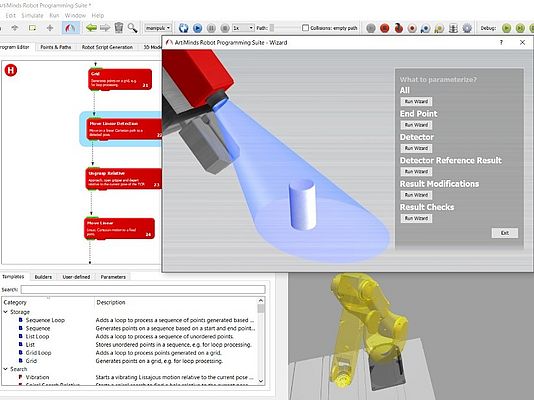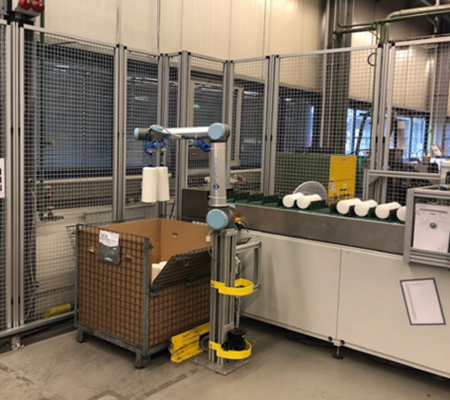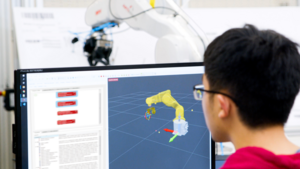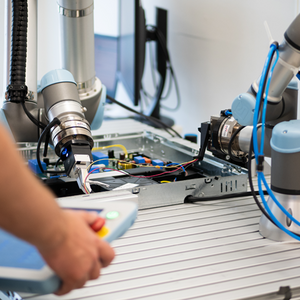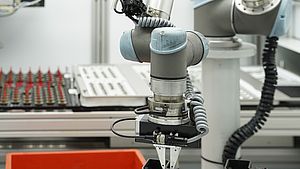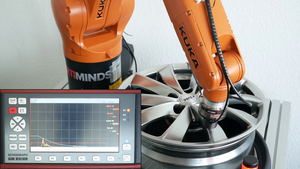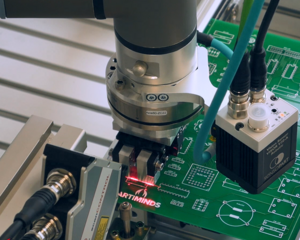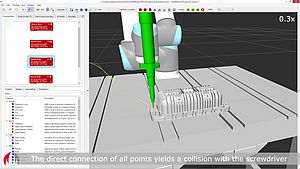Artiminds. The automotive supplier Mann+Hummel is the world market leader in filtration and employs 20,000 people at 80 locations worldwide. At its plant in Speyer, Germany, the company was looking for a solution to automate the loading of a screen-printing machine with air/oil separators. Previously a worker carried out this very monotonous and non-ergonomic task manually.
Now, they decided to solve this task using a cobot from Universal Robots. The cobot should pick two air/oil separators from a grid box and place them on a timed conveyor belt, on which the filters are transported to the screen-printing machine for printing.
Since the filters are provided partially sorted in several levels with intermediate storage, one challenge was the correct detection of the part position. Another requirement was that the detection jobs could easily be adapted to new variants of the filters.
To keep the robot application flexible and to be able to switch back to manual loading if, for example, the robot has to be adapted to a new product, it was decided to use a cobot in combination with a light grid to ensure safety. A SensoPart vision sensor that is mounted above the feeding box and that is directly connected to the robot should handle the detection of the picking position.
To stay as flexible as possible and to simplify the deployment of the application, Mann+Hummel decided to use the software ArtiMinds Robot Programming Suite (RPS) for the entire programming of the cobot, including the integration of the vision sensor. Sascha Mummert, Technology and Process Engineer at Mann+Hummel explains: “Our goal was to proof the possibilities of current robotics technology and build up appropriate internal know-how.”
“With suitable components and the right software, even complex robotic applications can be flexibly implemented by our own employees.”
ArtiMinds RPS makes it possible to generate robot programs intuitively and simply by drag and drop of predefined function templates. The desired task sequence can be put together in a modular way and the subsequent parameterization of the templates is done either offline in the CAD environment or online with the real robot with an intuitive wizard system. This allows the user to focus completely on the actual process and its implementation, which offers much more flexibility, especially when doing first steps in the field of robotics and gaining initial experience.
By including the CAD model of the grid box in the 3D simulation environment, the cell layout could already be checked regarding collisions and reachability of the cobot during cell planning. With this setup, collisions can automatically be avoided during robot programming. ArtiMinds RPS´ internal inter-face minimized the setup effort for the vision system and ensured a simple and standardized transfer of data to the robot.
The result: A transparent robot program that is autonomously executed by the robot without having written a single line of robot code. The execution of the program was possible independently from the ArtiMinds software since native UR Script code was generated automatically by ArtiMinds RPS.
Sascha Mummert summarizes: "The successful implementation of our pilot plant in Speyer has proven that with suitable components and the right software, even complex robotic applications can be flexibly implemented by our own employees."
Take aways of the Bin Picking application:
• ArtiMinds RPS simplifies the programming of sensor-based applications. In combination with sensor technology, even the program logic for cobot applications can quickly become very complex.
• The boxes are available in different variants. It was therefore important that the detection jobs could be easily adapted.
• External influences in production could not be completely ruled out, so robust detection had to be ensured.
• The installed application was to serve as a basis for further systems and the program created should therefore easily transferable to a new hardware setup.


